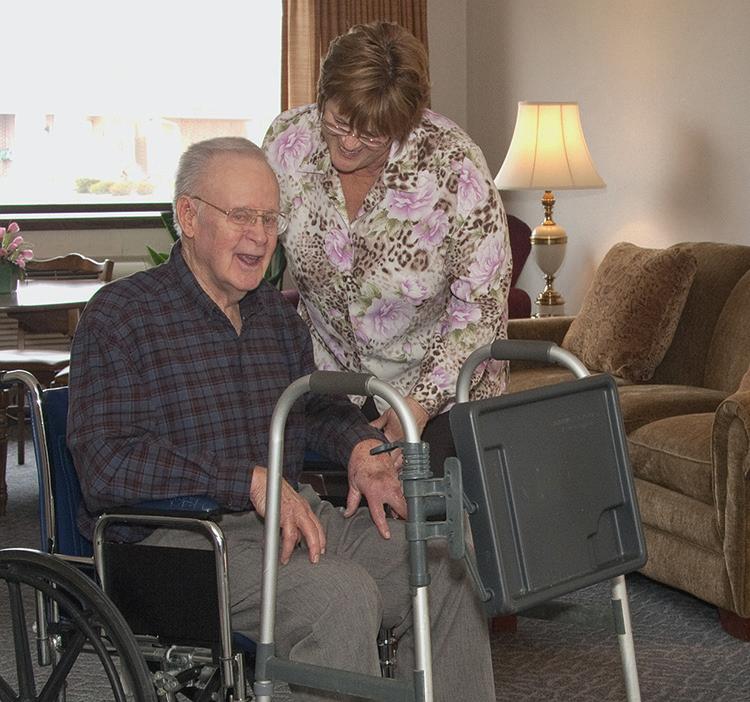




As seniors live longer, they may have opportunities to explore completely new career paths.
After retirement, older adults may want to explore second careers that help them inspire a new generation of people. Teaching is one such career.
A person is never too old to teach if he or she feels capable. In fact, more mature teachers may be coveted because they could bring life experience, social skills and flexibility to school districts.
While there are certain protocols in place to become qualified to teach, thanks to teacher shortages brought on by the recent global pandemic, many states now offer shorter routes to classrooms with alternative teacher certification programs that may not require master’s degrees.
There are various reasons seniors may want to consider becoming teachers, and there are many teaching positions and opportunities for their consideration.
Seniors can begin their pursuits as
substitute teachers. This option may not require any certification, and substitutes may only need to undergo background checks for eligibility to work in schools. Substituting enables individuals to work only as much as they desire.
Certain colleges and universities hire professionals to teach industry-specific college courses. For example, a certified public accountant may teach an introductory accounting class.
Adjunct professors typically are those who are still employed in their fields, but it may be possible to do this as a second career as well. This could be an option for someone who would like to devote more time to teaching at an advanced level.
These positions will require the most dedication and potentially certification in a specific area, such as grade level or
coursework. General education teaching requires a term commitment commensurate to the school year. And that commitment will be five days per week.
There may be more flexibility if one were to teach a specific special concentration class, such as a foreign language or art. However, certain school districts require such educators to float from school to school in the district during the week.
Seniors who aspire to shape the minds and skills of younger children could be drawn to preschool education. Education and other certifications to work in such settings may vary depending on the school.
This type of position is ideal for compassionate individuals who have the patience for youngsters who may be nervous being away from home.
Teaching is a potential second career for seniors looking for new challenges after retirement. Most alternative route certification courses are now offered online, which can align with any applicant’s schedule.
Exercise is widely recognized as a vital component of a healthy lifestyle. Despite that, a recent analysis of data from the 2020 National Health Interview Survey found that more than two-thirds of individuals are not getting enough exercise.
Though the survey was conducted amid the onset of the COVID-19 pandemic, which suggests the overall figures might be somewhat lower than they might have been had the data been collected in a more typical year, just 28 percent of respondents were meeting the physical activity guidelines established by the Centers for Disease Control and Prevention.
Routine exercise is beneficial for people of all ages, and seniors are no exception. Aging adults who want to be more physically active but think they are among the 72 percent of individuals who aren’t meeting CDC exercise guidelines can speak with their physicians and ask these three questions to ensure the transition to a less sedentary lifestyle goes smoothly.
A physician also can recommend certain activities depending on a person’s age and medical background. Though exercise is beneficial for everyone, certain activities may not be.
For example, AdventHealth notes that high-impact activities like jogging and jump rope may not be suited for individuals with arthritis.
In addition, aging individuals with physical limitations that require them to use a wheelchair should not write off their ability to exercise, as physicians can recommend exercises for patients with mobility issues as well.
Doctors may already be monitoring aging

individuals’ hearts even if they have not exhibited symptoms of heart problems in the past. However, it’s best to discuss heart health in greater detail prior to beginning a new fitness regimen.
In an interview with Penn Medicine, Neel Chokshi, MD, MBA, medical director of Penn Sports Cardiology and Fitness Program, noted the risk of heart attack or cardiac complications slightly increases when individuals begin to participate in a moderate or intense activity. So a physician might want to conduct a heart checkup in order to determine if a patient has an underlying heart condition.
Prescription medication use is another variable that must be taken into consideration before beginning a new exercise regimen.
The CDC notes that roughly 84 percent of adults between the ages of 60 and 79 use one or more prescription medications.
Each medication produces different effects, and a 2016 study published in the Methodist DeBakey Cardiovascular Journal noted that certain medications evoke an acute drop in blood pressure, which can disturb balance and increase fall risk, while others actually facilitate greater improvements in health outcomes.
That means the dynamic between medications and exercise is unique to each medication, which underscores the importance of speaking with a physician whenever a fitness regimen is started or tweaked and/or a new medication is prescribed.
These are just three of the questions seniors can ask when discussing exercise with their physicians. Seniors are urged to ask any additional questions they might have during such discussions.


Most seniors recognize that routine visits to their physicians are an important component of preventive health care. Annual physicals are important for everyone, but they’re especially important for individuals 65 and older who may be more vulnerable to disease and various other health conditions than younger adults.
The National Institute on Aging reports that millions of individuals 65 and older have visited their physicians and learned they have a condition known as prediabetes.
For some, the day they receive a prediabetes diagnosis also marks the first time they’ve heard of the condition. Since so many seniors are affected by prediabetes, it can behoove anyone to learn more about it.
The Centers for Disease Control and Prevention notes that prediabetes is a serious health condition characterized by higher than normal blood sugar levels. When a person has prediabetes, his or her blood sugar levels are not yet high enough to indicate type 2 diabetes, but that could change if prediabetes patients do not make changes to prevent such a progression.
How common is prediabetes?
A 2023 study published in the journal Diabetes Care indicates that 464 million individuals across the globe had impaired glucose tolerance (IGT) and 298 million had impaired fasting glucose (IFG) in 2021. Each of those conditions are hallmarks of prediabetes, cases of which the study indicates are expected to rise significantly by 2045.
The CDC notes that when a person has prediabetes, the cells in his or her body do not respond normally to insulin, which is a hormone produced by the pancreas that enables blood sugar to enter cells, which then use it for energy. The pancreas then makes more insulin to get cells to respond, but eventually the pancreas cannot keep up, resulting in a rise in blood sugar.
Many people have prediabetes for years and do not know it. In fact, the CDC reports that more than 80 percent of the 98 million American adults who have prediabetes are unaware that they do.
The sheer volume of people who have prediabetes but are unaware that they do begs the question of what individuals can do to learn if they have the condition before they develop type 2 diabetes. Recognition of the risk factors for prediabetes is a good start. The CDC urges anyone who has any of the following risk factors to speak with their doctor about having their blood sugar tested:
• Being overweight
• Being 45 or older
• Having a parent, brother or sister with type 2 diabetes
• Being physically active less than three times per week
• A history of diabetes during pregnancy (gestational diabetes) or giving birth to a baby who weighed more than nine pounds
• Having polycystic ovary syndrome
• Being African American, Hispanic/ Latino American, American Indian, or Pacific Islander. Some Asian Americans also are at greater risk for prediabetes.
Prediabetes can be a precursor to type 2 diabetes, which only highlights how important it is that older adults recognize their risk for the condition.

Seniors and older adults did not seem to get the memo regarding inflation. As the world continues to navigate a cost-of-living increase, internal data from Bank of America indicates that Baby Boomers (people born between 1946 and 1964) and Traditionalists (individuals born between 1928 and 1945) are spending more while younger generations are cutting back.
Between May 2021 and May 2022, spending by Traditionalists increased by more than 5 percent while Baby Boomer spending rose by 2.2 percent. That uptick occurred while younger generations’ spending fell by 1.5 percent.

Seniors seem to be on the go, and that’s something holiday shoppers can keep in mind as they look for gifts for their aging parents, grandparents and others.
With that in mind, shoppers can consider these gifts that align well with the lifestyles of seniors who are out and about and making the most of their free time.
• Golf clubs or additional golf gear: Data from the National Golf Foundation indicated that more than 34 million people in the United States played golf in 2019, and 15 percent of those players were 65 and over. A new set of custom-fit clubs can help seniors take their game to the next level.
Such clubs can be expensive, so they make a great tandem gift from children and grandchildren who pool their resources. If new clubs are not necessary or too costly, a single club, such as a new driver or putter, makes for a great gift as well. Gear like a new golf bag, new spikes and new coursefriendly attire also makes a great gift for seniors who love the links.
• Travel gifts: The 2023 AARP Travel Trends survey found that 85 percent of older travelers rank travel in their top three priorities for discretionary spending. The appeal of travel has not worn off for modern seniors, and shoppers can keep that in mind
this holiday season.
New luggage, travel miles earned through a credit card, unique experiences at senior travelers’ next destination, air tags that can keep track of luggage, and a world travel adapter that can convert plugs in any country across the globe are just a few of the many travel gifts shoppers can give on-the-go seniors this December.
• Exercise gear: The National Council on Aging notes that adults who exercise after turning 65 continue to reap the same rewards that improve quality of life among younger men and women.
In addition to boosting immunity, exercising after 65 continues to improve mood so long as seniors stay the course. Exercise gear, including attire and appropriate footwear, can reduce injury risk and help seniors feel more comfortable while breaking a sweat.
• Spa session: All that activity is good for the body, but so is a little post-activity rest and relaxation. A day at the spa, where seniors can get a massage, take a mental break and address minor aches and pains can be just the thing seniors need to recover in time for their next excursion.
Any number of gifts can make this holiday season even more special for modern seniors who continue to get up and go each day.
Data from the United States Bureau of Labor Statistics indicates there were roughly 37 million providers of unpaid eldercare across the United States in a recent two-year span of time.
The majority (59 percent) of eldercare providers are women, and individuals between the ages of 45 and 64 are the most likely to provide care. Unpaid caregiving also is significant in Canada, where the Canadian Centre for Caregiving Excellence reports Canadians devote 5.7 billion unpaid hours each year to caregiving.
In the U.S., data from the BLS indicates that nearly half of all eldercare providers provide care every day (24.3 percent) or several times per week (24 percent).
Full-time workers who provide eldercare in addition to their responsibilities at work provided an average of 2.65 hours per day of care.



“To All of the Wonderful People at Azura Memory Care, We would like to thank each and every one of you for taking care of our Mom with such loving kindness and compassion. We were so blessed to have her live in such an amazing home!! We appreciate everything you all do!”
Love, Mickelson Family
• High Caregiver to Resident Ratio
• Exclusive MOSAIC Connections Training; a required advanced dementia and engagement education system featuring the Virtual Dementia Tour
• Personalized Life Engagement Programming; featuring MOSAIC Therapies of Cognitive Stimulation, Creativity, Exercise, Community Participation and more!
• Medication Management
• Secured Entrance and Exits
• Incontinence Care
• Behavioral Expression Management
• Electric Charting System
• On-site Beautician, Dental Care, Podiatry, Physician, Home Health Therapies and Hospice Care
• Unique MOSAIC Dreams Program!

The early years of midlife are a hectic time for many people. Around the time many people reach their late 30s and early 40s, they’re balancing the responsibilities of a career and a family.
But as people enter their 50s, some of those responsibilities tend to be less significant, leaving more time for recreational pursuits.
Hobbies and other pursuits outside of work are often more fun when enjoyed with friends. People over 50 undoubtedly recognize that it’s not always so easy to make new friends, even though it’s undeniably beneficial to have supportive relationships into your golden years.
A recent study from researchers at Michigan State University found that valuing friendships was a stronger predictor of health and happiness among older adults than valuing family.
Those results align with an earlier Australian study that found Australians age 70 or older tended to live significantly longer if they had more strong friendships.
Making friends after 50 might not be as simple as it was during your school days, but these strategies can help men and women in midlife build new friendships.
Fiftysomethings who have spent the last couple of decades building a career and raising a family can give some serious thought to their interests outside of work or passions they hope to pursue now that they have more time to commit to such pursuits.
The more interested you are in a given activity, the more likely you are to stick with it. And the longer you stick with something, the more likely you are to meet like-minded individuals (i.e., future friends) willing to make similar commitments.
In years past, men and women over 50 may not have had any readily available tools to reach out and connect with new people.
Social media has made it much easier to build such connections. Even the most obscure passions likely have a social media group of locals devoted to them, and these groups can be great ways to meet new people.
A local runner’s club may have its own social media accounts, and local governments and community groups often
share information about sports leagues and other groups via social media.
Communities often sponsor group outings to museums, the theater, sporting events, and other day trips.
Signing up for a bus trip to a local museum presents a great opportunity to meet people who share your interests, providing the potential to build lasting friendships built on a foundation of shared interests.
Just because you’re in your 50s doesn’t mean your friends have to be. Don’t hesitate to invite younger or older acquaintances and colleagues over for dinner or on weekend excursions.
Friends come in all shapes, sizes and ages, so you could be missing out if you’re not willing to extend a hand in friendship to people of different ages and backgrounds.
Making friends after 50 can be challenging. However, various strategies can help men and women over 50 connect with new people.
The Parkinson’s Foundation reports that the right foods can optimize Parkinson’s medications, helping patients ease their symptoms, maintain strong bones and preserve overall health and fitness. Constipation is a common symptom of Parkinson’s disease, but the PF notes that drinking six to eight glasses of water per day and eating fiber-rich foods like brown rice, whole grains and fruit can ease constipation and certain digestive difficulties that also can be a byproduct of the disease.





Reaching one’s 50th birthday in optimal health is an accomplishment to be proud of. The hard work required to be healthy in midlife includes adhering to a nutritious diet and exercising regularly.
Once individuals cross the threshold and enter their 50s, they can look to some additional strategies to maintain their physical and mental well-being for decades to come.
• Get a pet. Many people 50 and older qualify as “empty nesters,” a term applied to adults whose children have grown up
and moved out of their homes. Some empty nesters experience a phenomenon known as “empty nest syndrome,” which the Mayo Clinic notes can be marked by feelings of sadness or loss. Pets can help people over 50 with no children at home overcome feelings linked to empty nest syndrome.
A recent University of Michigan National Poll on Healthy Aging found that 86 percent of pet owners felt their pets make them feel loved while 73 percent said their pets provided a sense of purpose. Pets also can ensure individuals over 50 stay physically active and provide opportunities to connect with other people.
• Prioritize learning. Whether it’s taking music lessons, going back to school or mastering a new hobby, learning has a profound effect on aging brains. For example, a recent study published in the journal Psychological Science found that memory function is improved by engagement in demanding everyday tasks.
That study reported that people who learned new skills experienced greater memory improvement than people who only socialized or participated in activities that were not as cognitively engaging.
• Make an effort to improve balance. Various factors contribute to a decline in balance as adults age. For example, a decline
in muscle mass that begins when people are in their 30s is a normal part of aging.
Over time, that natural decline affects strength and agility. Balance exercises can be a valuable component of a fitness regimen that help individuals reduce their risk for falling as they advance through their 50s and into their 60s and 70s. That’s a significant benefit, as the Centers for Disease Control and Prevention reports that one out of every three adults age 65 and older experiences a fall each year, and as many as 30 percent of those falls lead to serious injury.
• Embrace your inner socialite. Socialization is important for people of all ages, including individuals 50 and over. A recent study from researchers at Michigan State found that valuing friendships was a strong predictor of health and happiness among older adults.
Opportunities to socialize with friends may increase as people navigate their 50s and children move out or become more independent. Individuals can take advantage of opportunities to socialize whenever possible.
Various strategies can help people maintain mental and physical wellness as they make their way through their 50s and beyond.


The decision to move into an assisted living facility requires careful consideration, and that decision may necessitate even greater deliberation for couples.




The organization SeniorLiving.org, which is devoted to empowering older adults to age with ease, notes that many assisted living facilities offer living arrangements for spouses who do not necessarily require the same level of care and attention as their partners.
Though each facility is different, and some may not allow couples to live together when one person requires significant help with day-to-day living, many provide apartment-style living in which housing units are equipped with safety features, such as handrails and wheelchair accessibility, that can make daily living safer for aging individuals with physical challenges without making life difficult for their partners with no such issues.
In addition, SeniorLiving.org notes that, at most assisted living facilities, residents will only pay for the services required, meaning couples will not have to pay for services such as medication management and activities of daily living assistance for the spouse who does not require such help.
Such flexibility can make life easier and more affordable for couples who choose to move into assisted living facilities together.




Retirement provides individuals with ample time to engage in activities they enjoy. Many seniors spend that newfound free time relaxing and seeing the sights.
Seniors are a travel-friendly demographic. The World Tourism Organization says that, in 1999, more than 593 million international travelers were age 60 years and older. Seniors are projected to take two billion trips annually by 2050. As Baby Boomers and Generation Xers continue to retire, a larger portion of the overall population will have time to travel.
When seniors plan trips, they have many ways to get around in style.
Cruising can be an ideal way for older adults to travel. Cruise ships depart from ports across the world and travelers can choose from an array of itineraries. People can travel on cruises that are at sea for as few as three to five days to others that are out for weeks at a time.
One reason seniors enjoy cruising is because it’s all-inclusive with little extra planning required. Step aboard a cruise ship and enjoy a floating hotel complete with food, lodging, entertainment, shopping, gambling, and much more. Organized excursions at ports of call can add to the thrill of cruising.
Escorted tours are another option seniors may want to consider. By working with reputable tour operators, seniors can engage in affordable, safe and comfortable tours via bus, train or other modes of travel.
Tour companies take the work out of the trips by handling the details and showcasing the best locales. Tour experts know when to schedule meals and sightseeing to avoid the crowds so that everyone can sit back and relax on their adventures.
Travel by recreational vehicle is a great way for individuals with time on their hands to see the sights up close and personal. When RVing, the time spent traveling is the adventure, and the destination is simply the cherry on top.
The RV industry exploded during the pandemic because it provided a safe way to enjoy a vacation and get away from home.
MARVAC Michigan RV & Campgrounds says currently more than nine million households own an RV in the United States.
There’s no age limit to buying an RV, although the RV Industry Association says the average owner is 48-years-old and married.
RV-friendly campsites and parks enable
travelers to mingle with each other, providing affordable and fun ways to travel.
Seniors who got in on the timeshare bandwagon early in life can choose to enjoy their travel years even further. The timeshare model enables buyers to purchase the right to use particular homes, condos, hotel rooms, resorts, or other accommodations for specific periods of time. For example, some timeshare agreements are for one week each year in a designated location. Seniors with more time on their hands may want to revisit timeshare agreements to increase the frequency in which they can use properties or to find timeshare companies that enable swapping properties with others so that different locales can be enjoyed.
Retirees may aspire to spend more time with family members who do not live nearby. Families may want to consider mother-daughter residences or properties with small guest houses so that seniors can stay in the residences when visiting but have some privacy at the same time.
Seniors have many travel options, and retirement is the ideal time to get out and enjoy time away from home.


Cardiovascular disease claims more lives across the globe every year than any other disease or condition, and many of those fatalities are credited to heart disease.
Though the terms “cardiovascular disease” and “heart disease” are often used interchangeably, the National Heart, Blood and Lung Institute notes that, while all heart diseases are cardiovascular diseases, not all cardiovascular diseases are heart diseases.
This is an important distinction, especially as adults discuss heart and cardiovascular health with their physicians.
The NHLBI reports that more than one in 10 American adults have been diagnosed with heart disease, which underscores the serious threat posed by the various conditions that fall under the umbrella of the condition. Though NHLBI data indicates around 630,000 Americans die from heart diseases each year, many of those deaths are preventable.
The same goes for Canada, where data from the Canadian Chronic Disease Surveillance System indicates that every hour roughly 14 Canadian adults age 20 and over with diagnosed heart disease lose their lives.
Education is one of the ways in which deaths due to heart disease can be prevented. That’s especially true when individuals learn to recognize warning signs of the disease and take prompt action once such indicators appear.
• Chest pain: Discomfort between the neck and upper abdomen is characterized as chest pain, which does not necessarily indicate the presence of heart disease.
However, the experts at Mount Sinai indicate that chest pain is the most common symptom of poor blood flow to the heart or a heart attack. Chest pain may occur because the heart isn’t getting enough oxygen or blood. It’s important that individuals recognize that the intensity of pain in the chest does not indicate the severity of the problem. That means that even mild discomfort in the chest should be brought to the attention of a physician immediately.
• Shortness of breath: Shortness of breath can occur because the heart isn’t pumping blood as well as it should, thus causing blood to back up in the veins that go from the lungs to the heart.
Mount Sinai notes that this results in fluid leaking into the lungs, thus producing shortness of breath. Shortness of breath can occur at any time, including when individuals are active or at rest.
• Coughing or wheezing: Another indicator of fluid buildup in the lungs related to the heart is persistent coughing or wheezing. When coughing, individuals may spit up a pink or bloody mucus.
• Swelling in the lower legs: Mount Sinai notes that swelling in the legs, ankles or feet is another indicator of heart troubles. One of the byproducts of a poorly functioning heart is slower blood flow, and that reduction in flow can cause a backup in the veins of the legs. That backup can cause fluid to build up in the tissues, which leads to swelling. Heart disease is a significant threat to public health. Learning to recognize signs of the disease can save an untold number of lives.

Various changes are associated with aging, and these can be physical, mental and emotional. Though each person manages these changes in their own way, there’s no denying that social interaction can benefit people from all walks of life as they navigate their golden years.
The Foundation for Senior Care says socializing can give seniors a sense of purpose, stimulate the mind, relieve boredom, potentially prevent feelings of depression, and give individuals something to look forward to. The senior living center Aston Gardens says socialization provides a significant boost to the cognitive health of older adults, helping to prevent or delay conditions that can affect memory.
Individuals looking to cultivate healthy social interactions may turn to clubs and other groups. If there’s a dearth of opportunities, individuals can start and promote their own social club using this useful guideline.
Social clubs can meet and be organized around any number of themes or interests. Social clubs may meet to discuss gardening, crocheting, reading, or other shared hobbies. Friends also may be interested in doing food and beverage sampling. In such instances, a luncheon social club makes perfect sense.
Meeting details can be posted in a community bulletin or on a message board at a local house of worship. However, the internet can be a speedy messenger and help like-minded people figure out how to connect.
Facebook groups are one way to organize social clubs, as is the website Meetup.com. The latter is a large online network of offline groups that meet all over the country and the world. The website makes it a snap to organize a local group or find an existing club.
Conduct a search of groups already meeting within a 50-mile radius to see if an existing group already meets your criteria. If not, proceed full speed ahead as you establish your own club.
Most people prefer a schedule so they can plan their days accordingly. Choose a regular meeting time and place to hold the social club; otherwise, it can be confusing to accommodate everyone. Inconsistency also can make it hard to get the club off the ground.
For those new to hosting social clubs, it may be better to begin with only a few members as everyone gets into a groove.
As the group becomes more established, it can be opened up to more members. Although it may be wise to cap membership so that things are more easily managed.
Social clubs are a great way for seniors to stay connected and active. When there isn’t one that meets a person’s interests, it’s relatively easy start one from scratch.
(METRO CREATIVE)
Aging is associated with certain ailments, some of which concern seniors more than others. One of the conditions many older adults worry about is dementia, particularly in the form of Alzheimer’s disease.
Though there’s no cure for Alzheimer’s disease, recent research suggests reducing blood sugar may be associated with a lower risk.
Doctors and researchers have determined a link between high blood sugar levels and the formation of dementia, which includes a loss of memory and thinking skills that afflicts millions of older people.
A recent study published in the New England Journal of Medicine found that,
even when diabetes was not evident, there is a correlation between sugar and dementia. A blood sugar level above normal levels (depending on activity level and weight, among other factors) can contribute to an elevated risk of developing dementia.
Furthermore, a longitudinal study published recently in the journal Diabetologia, which followed 5,189 people over 10 years, found those with high blood sugar had a faster rate of cognitive decline than those with normal blood sugar — whether or not those blood sugar levels classified the people as being diabetic.
The link could be due to an enzyme that breaks down insulin. Insulindegrading enzyme, a product of insulin that breaks down both insulin and amyloid proteins in the brain, which are the same proteins that can lead to Alzheimer’s disease, is a factor in the connection to dementia. Melissa Schilling, a professor at New York University, reviewed studies and found that people who have type 1 diabetes and don’t produce enough insulin can’t break down the amyloid proteins naturally. Furthermore, those who take
insulin to treat diabetes can end up with a surplus of insulin in the body.
The insulin-degrading enzyme gets used up trying to break the surplus down. This doesn’t leave enough enzyme to tackle amyloid brain clumping proteins.
These same scenarios can occur in people if their blood sugar levels are elevated, even if they don’t have diabetes yet.
Data published by Harvard Health Publishing indicates “any incremental increase in blood sugar was associated with an increased risk of dementia.”
Individuals who have elevated blood sugar levels, or roughly 100 mg/dL or higher after a fast, can tame sugar levels by exercising, losing weight and shifting away from highly refined grains. Individuals also may want to favor a Mediterranean style of eating, which focuses on fish, olive oil, fruits, vegetables, and beans over a processed carbohydrate- and sugar-laden diet.
High blood sugar is another factor linked to the formation of Alzheimer’s disease and other dementias. Making lifestyle changes can keep seniors healthy throughout their golden years.

The heart has been characterized as the engine that makes the human body run. If that metaphor is not exactly spot-on, it still serves as a good indicator as to just how vital a healthy heart is to the human body.
Despite the importance of a healthy heart, diseases that affect the heart remain the single greatest cause of death across the globe.
According to the World Health Organization, cardiovascular diseases (CVDs) are the leading cause of death globally, claiming roughly 18 million lives each year.
Various factors can adversely affect how well the heart functions, and that includes irregular heart beat, also known as arrhythmia. Atrial fibrillation (AFib) is the most common form of arrhythmia, and it behooves anyone to gain a greater understanding of this condition.
The Cleveland Clinic notes that AFib is an arrhythmia that begins in the upper chambers of the heart known as the atria. When a person has AFib, these chambers beat irregularly, and the American Heart Association reports that, when this occurs, blood pools in the area because not
enough blood is being pumped out of the atria. That pooled blood can clot and pose a serious threat.
What happens if a blood clot forms?
The AHA notes that, if a clot forms, the blood can be pumped out of the heart to the brain, which blocks the blood supply to the brain and ultimately results in stroke.
In fact, AHA data indicates between 15 and 20 percent of people who have strokes have AFib. In addition, the Heart and Stroke Foundation of Canada reports that one-fourth of all strokes affecting people 40 and older are caused by AFib.
The Cleveland Clinic notes that some people with AFib experience no symptoms. Such is the case in people whose ventricles are beating at a normal or slightly elevated pace. When ventricles begin to beat faster, then individuals may experience symptoms that can include:
• Extreme fatigue
• Irregular heartbeat
• Heart palpitations
• Feeling of butterflies or fish flopping in the chest
• Dizziness or lightheadedness
• Fainting
• Shortness of breath
• Chest pain
The AHA notes that adopting and maintaining a heart-healthy lifestyle is the best way to control AFib risk. Such a lifestyle includes:
• Regular physical activity
• Adherence to a heart-healthy diet that is low in salt, saturated fats, trans fats, and cholesterol
• Controlling blood pressure, including management of high blood pressure
• Avoid excessive consumption of alcohol and caffeine
• Avoid smoking
• Maintain healthy cholesterol levels
• Maintain a healthy weight
Researchers behind a recent study published in the journal Progress in Cardiovascular Diseases note that AFib has sometimes been characterized as the cardiovascular epidemic of the twenty-first century.
Such a characterization underscores how significant a global health threat AFib can be. More information about AFib can be found at heart.org.

Of the roughly 55 million people around the world living with dementia, 60 to 70 percent are estimated to have Alzheimer’s disease, reports the Mayo Clinic.
Alzheimer’s disease is a progressive brain disorder marked first by mild memory loss that can worsen and lead to problems with communication and an inability to perform the activities of daily life. The condition is named for Dr. Alois Alzheimer.
In 1906, Alzheimer noticed changes in the postmortem brain tissue of a woman who had died of unusual mental illness, which included symptoms of language problems, memory loss and unpredictable behavior. Her brain showed many abnormal clumps and tangled bundles of fibers. According to the National Institute on Aging, doctors now know those clumps are amyloid plaques and the tangles are hallmarks of the disease.
The National Institutes of Health says Alzheimer’s disease is the seventh leading cause of death in the United States and is the most common dementia among older adults.
While most people are familiar with Alzheimer’s, there is much more anyone
can learn. The following are some interesting facts about Alzheimer’s.
• The most common symptoms of Alzheimer’s involve a gradual decline in memory, reasoning, language, coordination, mood, and behavior.
• The Cleveland Clinic says the buildup of plaques and tangles from an overabundance of amyloid and tau protein production block the communication between nerve cells and cause brain cells to die, thus contributing to Alzheimer’s. Nerve cell death starts in the hippocampus, the area of the brain that controls memory. Doctors are not entirely sure what causes this protein build-up.
• Many times family members are the first to recognize a friend or loved one forgetting newly learned information, especially recent events, places and names.
• Issues with thinking and reasoning may include not wearing the right clothes for the weather or not knowing to use oven mitts when taking hot items out of the oven.
• Changes in the brain can begin years before initial symptoms appear, according to the Centers for Disease Control and
Age is the biggest risk factor for Alzheimer’s. Researchers believe that genetics may play a role, but a genetic predisposition to Alzheimer’s does not make it an inevitability.
• A healthy lifestyle, which includes adequate physical activity, a nutritious diet, limited alcohol consumption, and not smoking, may help people avoid Alzheimer’s.
• Alzheimer’s can rob a person of his or her personality. As the disease becomes more severe, mood swings, anger, depression, and anxiety may occur. This is combined with the patient forgetting who family members are and potentially lashing out or being disinterested in visitors.
• There is no cure for Alzheimer’s, but doctors use medical management to improve quality of life for patients and their caregivers. Treatments may help maintain brain health and manage behavioral symptoms.
Alzheimer’s disease was first diagnosed at the start of the 20th century. Nearly 120 years later, it remains a major health issue affecting millions of people worldwide.